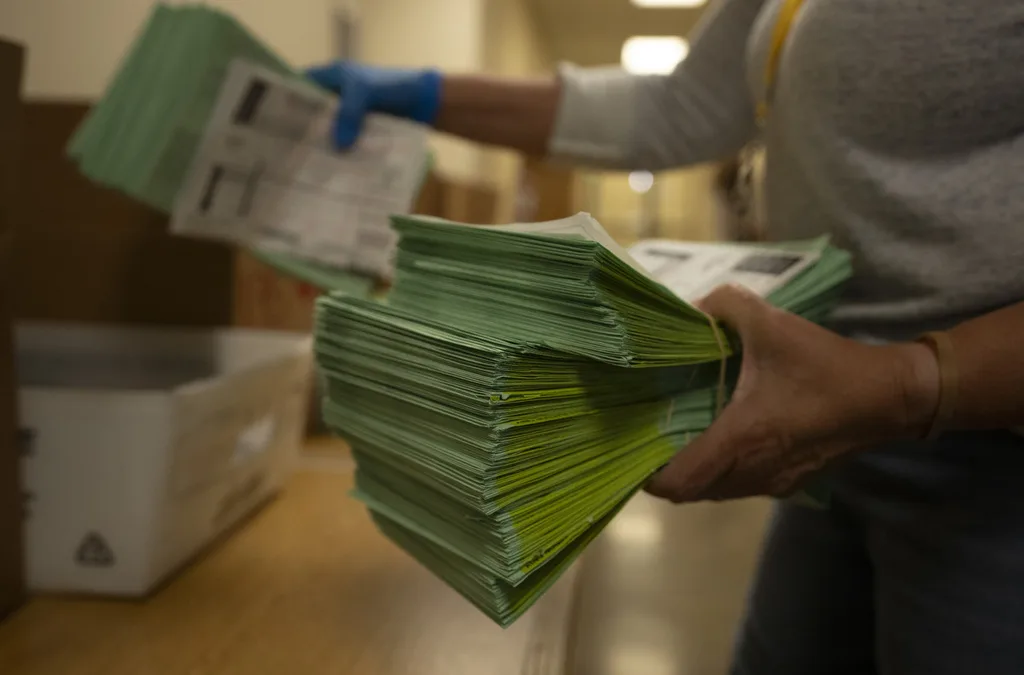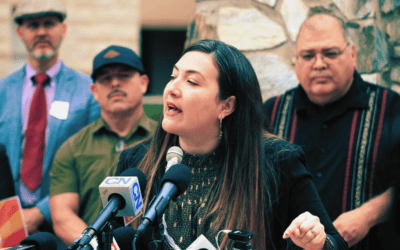
The winning team in Phoenix's first Innovation Challenge holds its $3,500 check on April 6, 2023. (Photo by <a href="https://cronkitenews.azpbs.org/people/gianna-abdallah/" rel="noopener" target="_blank">Gianna Abdallah</a>/Cronkite News)
Members of the winning team said every Phoenix resident should have access to chilled drinking water within five minutes of their local bus stop.
In its first public challenge, the Phoenix Office of Innovation gave residents a problem to solve: Come up with creative ideas for providing chilled drinking water in public places like parks and bus stops. The team with the best solution would win a cash prize.
Five teams answered the call. And on April 6, after six hours of collaboration, they waited while a robot driven by the Phoenix Union High School District Phoenix Robotics team rolled through Venture Café in downtown Phoenix with an envelope containing the name of the winning team.
A total of 27 participants were split up into teams of five or six and had to work together to devise a plan. The teams then presented their ideas to a panel of judges.

Team 3 won the challenge. Its members were Norman Rodriguez, Katrina Detmer, Jordan Fourcher, Emily Nguyen and Steven Cox and each took home $700. Team members said every Phoenix resident should have access to chilled drinking water within five minutes of their local bus stop.
The winning idea was a fountain made with a polycarbonate shell, the same material used to make bulletproof glass, instead of metal so it would not absorb heat and would be resistant to vandalism. Water would be cooled using thermoelectric plates. A shade structure with an active cooling roof would shade people from the hot Phoenix sun. Art installations would adorn the outside of the structure.
Judges liked the $4,500 projected price of each unit, that it would be all locally produced, and that city officials could monitor data about how much water was being used.

Chief Innovation Officer Michael Hammett said the Phoenix Office of Innovation wanted to engage the community and reward people for their ideas.
“We are having our first Innovate Phoenix Challenge, and that is bringing together the innovation community, and coming to the community with a problem the city is facing and asking these innovators to come up with solutions,” he said. “In this case, it’s expanding access to drinking water in public places. Drinking water that’s chilled.”
Rodriguez, Team 3’s captain and president of Elevate, an Arizona company that provides training for people looking for entry-level technology jobs, said Phoenix has water fountains, but “they rarely work, they’re very difficult to find, and they’re certainly never cooled.”
RELATED: Arizona AG Kris Mayes Revokes Water Permits for Saudi Arabia-Owned Farm
Fourcher, also a member of Team 3, said he’s worked on similar projects, and “it’s really incredible to see that the technology that I’ve been working on for the past two years is actually being judged and evaluated successfully by the city.”
Fourcher is chief executive officer of Cryo-X, which created a vinyl sticker that it claims will cool any outdoor surface. Its flagship product is a phone case that it said gets colder in the sun without using electricity.
Fourcher said the cooling roof proposed in their idea is possible because of his company’s radiative cooling technology.
Ideas from other teams included (some teams offered more than one solution):
- A water refill station in the shape of a tree with misters at the top to cool users.
- Water dispenser units in pre-existing buildings with awareness campaigns so residents know where dispensers are located.
- An app that contains the locations of water dispensers. Users could also add reviews on the quality of the water.
- Solar-powered water dispensers.
- Local vegetation incorporated with the design.
- Placing the water refill stations in neighborhoods that are high on the heat-index map.
The second-placed team won $1,500.
Winning the challenge does not mean the idea will come to life in Phoenix, according to Hammett, but will be considered, and portions of the ideas may be used.
The event was in partnership with the Phoenix Office of Innovation and Venture Café, a global company that sets up weekly meetings in cities to bring startup founders, researchers, investors and entrepreneurs together to brainstorm ideas. The Phoenix Venture Café opened downtown in April 2022.
The Phoenix Office of Innovation partners with residents, city departments as well as local and national organizations to create solutions to the city’s challenges.
“To solve an important challenge, Phoenix is tapping into one of our greatest resources — our creative and enterprising residents,” Phoenix Mayor Kate Gallego said in a press release. “Expanding public access to drinking water, especially in areas of high pedestrian and public transit, is essential to keeping our residents comfortable and safe.”
In the call for ideas, the innovation office offered details to consider in their proposals:
New technologies to provide drinking water in public spaces that could make a system more accessible.
- Non-tech ideas to provide access to drinking water without using plastic water bottles
- Cooling and shading efforts to keep the systems cool so the water stays cool in extreme heat.
- Education and communication strategies around the systems to build interest and encourage people to use the bottle-filling stations.
- Innovative ideas for maintenance and preventing vandalism, such as tech solutions or wrap-around support from the community or businesses.
- Adding a public art component to support the project and encourage community engagement and preservation of the system.
- Sustainable ways to alert if a system isn’t functioning properly and potentially losing water, as well as providing alternative options for those who forget their water bottle and would like to use a water filling station.
Looking for the latest Arizona news? Sign up for our FREE daily newsletter.

He said what? 10 things to know about RFK Jr.
The Kennedy family has long been considered “Democratic royalty.” But Robert F. Kennedy, Jr.—son of Robert F. Kennedy, who was assassinated while...

Here’s everything you need to know about this month’s Mercury retrograde
Does everything in your life feel a little more chaotic than usual? Or do you feel like misunderstandings are cropping up more frequently than they...

Arizona expects to be back at the center of election attacks. Its officials are going on offense
Republican Richer and Democrat Fontes are taking more aggressive steps than ever to rebuild trust with voters, knock down disinformation, and...

George Santos’ former treasurer running attack ads in Arizona with Dem-sounding PAC name
An unregistered, Republican-run political action committee from Texas with a deceptively Democratic name and ties to disgraced US Rep. George Santos...




